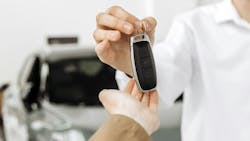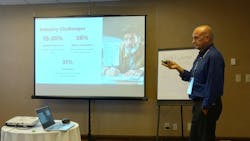Shops Must Sell Repairs to Close the Deal
Collision repair shops can’t wait for business to walk in the door and hand it to them. When a potential customer comes in, the shop needs to close the deal.
Shops are facing a 15-20% drop in repair volume, customers are facing 26% higher deductibles, and 31% more customers are taking insurance money without doing the repairs. Jim Lovejoy, senior services consultant at AkzoNobel, discussed the strategies shops need to use during Momentum, the 2025 Collision Industry Experts Event, in Orange, California, in July. He told shop owners in attendance they need to embrace sales culture.
“When you educate them, and you take steps to figure out what their needs are and sell to their needs, you earn the right to get that business,” Lovejoy said.
Pre-COVID-19, closing ratios for shops were around 75-80%. Now, they’re down to 64%, Lovejoy said. He outlined a five-step strategy shops can use to close the deal and secure the sale.
“The most profitable shops dropped 16 points; that’s a pretty good drop,” he said. “We became order takers. Now, we have to dust off the sales toolbox and figure out how to sell.”
Make a Positive First Impression
It starts with engaging the customer the moment they walk in the shop. Visual connections, verbal impressions, and rapport are all critical to a good first meeting. Lovejoy’s tips include making eye contact, standing up to greet the customer, using a confident tone, speaking clearly, using the customer’s name, asking thoughtful questions, and showing genuine interest.
“All of these things make an impression on people, especially when you have things that are highly technical,” Lovejoy said. “We’re trying to use language that they would understand; there’s a lot to explain, and we don’t want to bore them to death.”
Identify the Customer's Needs
Step two is identifying the customer’s needs. Asking open questions, practicing active listening, identifying the customer’s key motivators, and documenting the details to tailor a personalized solution all contribute to making the sale. It's crucial to avoid "yes" or "no" questions and find out what's important to their repair.
“What was their impression of the last repair experience they had? Was it good? Was it bad?” Lovejoy asked. “We can ask a few more questions – 'Why was it a good experience?' 'What did they not do very well?' So, we can make sure we don’t do those things wrong.”
“The most common thing I hear is, ‘Let us know if we can help you’...That’s a closing goodbye. You might as well push them out the door.”
Explain the Solution
Step three is explaining the solution; sell the customer what the car needs, why it needs it, and, most importantly, why your shop is the best place for the job. Lovejoy pointed out that a key factor in a positive customer experience is dependent on the employees. Better work environments lead to better morale, better service, and better retention.
“The level of the customer experience rarely rises above the level of the employee experience,” he said. “If you want your employees to provide top notch service to customers, the employees should feel they’re top-notch, also. Just something to think about from a retention standpoint.”
Earn the Business
Step four is earning the business. Request a repair authorization clearly and confidently. Lovejoy recommended using assumptive clauses, such as “When would you like to schedule the repair?” or suggestive clauses, such as “Many customers prefer to start repairs right away.” He told the attendees they need to create a sense of urgency by suggesting schedule times and how fast slots are filling up; avoid a passive approach.
“The most common thing I hear is ‘Let us know if we can help you,’” Lovejoy said. “That’s about as passive as you can get, and that’s about as far away from asking for a sale as you can get. That’s a closing goodbye. You might as well push them out the door.”
Eliminate Objections
The final step is eliminating objections. If there are pricing concerns, focus on the value, not just the cost. Explain the long-term benefits of the proper repairs in your estimate. Demonstrate the quality with examples of past work and provide a lifetime warranty for repairs. Share the credentials and experience of your repair team to build trust that you can handle their vehicle.
“We’ve told them everything we can do that sells to their needs and their pain points. When we try to close, an objection comes out. This is where true selling begins,” Lovejoy said. “If they have any concerns about different parts of the process, we can have them meet technicians. The more people they meet and kind of get to know a little bit — that little familiarity with who will be working on their vehicle — if they have concerns, that can go a long way.”
Lovejoy emphasized the use of "why" questions to understand objections and plan appropriate responses. If a customer wants to consult with someone they trust before making a decision, schedule a follow-up phone call after that takes place. If they can’t afford the deductible, does your shop offer financing? Understanding customers’ objections and calmly putting their concerns at ease is the final crucial hurdle to closing the deal. It’s difficult, but it’s something the industry needs to get back to doing if they want to get more cars in the door.
“In the last four years, we became order takers,” he said. “We need to go back to what we used to have to do to get the size of the pie that we wanted, which is to have closing skills. It’s work.”
Additional Reading: Attendees Build Momentum at AkzoNobel Collision Industry Experts Event
About the Author
Peter Spotts
Associate Editor
Peter Spotts is the associate editor of FenderBender and ABRN. He brings six years of experience working in the newspaper industry and four years editing in Tech. He has a bachelor's degree in journalism from Western New England University with a minor in integrated marketing communications and an MBA. A sci-fi/fantasy fan, his current 2010 Honda Civic is nicknamed Eskel, after the character from the Witcher book series, for the scratch marks on its hood.
Don't miss Peter's next article. Sign up for FenderBender Today's Collision Repair News here.


